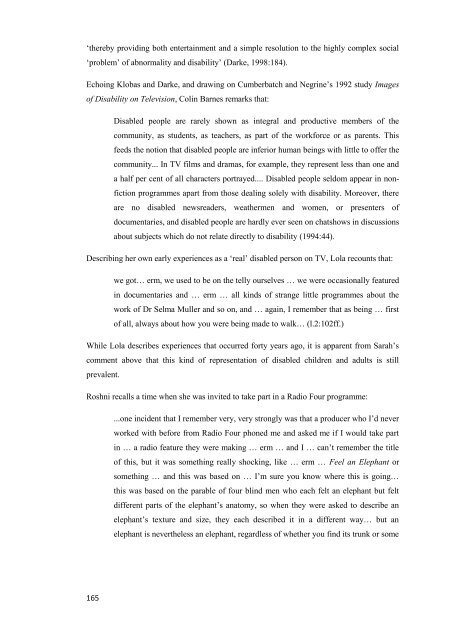A thesis submitted in partial fulfilment of - Etheses - Queen Margaret ...
A thesis submitted in partial fulfilment of - Etheses - Queen Margaret ...
A thesis submitted in partial fulfilment of - Etheses - Queen Margaret ...
You also want an ePaper? Increase the reach of your titles
YUMPU automatically turns print PDFs into web optimized ePapers that Google loves.
„thereby provid<strong>in</strong>g both enterta<strong>in</strong>ment and a simple resolution to the highly complex social<br />
„problem‟ <strong>of</strong> abnormality and disability‟ (Darke, 1998:184).<br />
Echo<strong>in</strong>g Klobas and Darke, and draw<strong>in</strong>g on Cumberbatch and Negr<strong>in</strong>e‟s 1992 study Images<br />
<strong>of</strong> Disability on Television, Col<strong>in</strong> Barnes remarks that:<br />
165<br />
Disabled people are rarely shown as <strong>in</strong>tegral and productive members <strong>of</strong> the<br />
community, as students, as teachers, as part <strong>of</strong> the workforce or as parents. This<br />
feeds the notion that disabled people are <strong>in</strong>ferior human be<strong>in</strong>gs with little to <strong>of</strong>fer the<br />
community... In TV films and dramas, for example, they represent less than one and<br />
a half per cent <strong>of</strong> all characters portrayed.... Disabled people seldom appear <strong>in</strong> non-<br />
fiction programmes apart from those deal<strong>in</strong>g solely with disability. Moreover, there<br />
are no disabled newsreaders, weathermen and women, or presenters <strong>of</strong><br />
documentaries, and disabled people are hardly ever seen on chatshows <strong>in</strong> discussions<br />
about subjects which do not relate directly to disability (1994:44).<br />
Describ<strong>in</strong>g her own early experiences as a „real‟ disabled person on TV, Lola recounts that:<br />
we got… erm, we used to be on the telly ourselves … we were occasionally featured<br />
<strong>in</strong> documentaries and … erm … all k<strong>in</strong>ds <strong>of</strong> strange little programmes about the<br />
work <strong>of</strong> Dr Selma Muller and so on, and … aga<strong>in</strong>, I remember that as be<strong>in</strong>g … first<br />
<strong>of</strong> all, always about how you were be<strong>in</strong>g made to walk… (l.2:102ff.)<br />
While Lola describes experiences that occurred forty years ago, it is apparent from Sarah‟s<br />
comment above that this k<strong>in</strong>d <strong>of</strong> representation <strong>of</strong> disabled children and adults is still<br />
prevalent.<br />
Roshni recalls a time when she was <strong>in</strong>vited to take part <strong>in</strong> a Radio Four programme:<br />
...one <strong>in</strong>cident that I remember very, very strongly was that a producer who I‟d never<br />
worked with before from Radio Four phoned me and asked me if I would take part<br />
<strong>in</strong> … a radio feature they were mak<strong>in</strong>g … erm … and I … can‟t remember the title<br />
<strong>of</strong> this, but it was someth<strong>in</strong>g really shock<strong>in</strong>g, like … erm … Feel an Elephant or<br />
someth<strong>in</strong>g … and this was based on … I‟m sure you know where this is go<strong>in</strong>g…<br />
this was based on the parable <strong>of</strong> four bl<strong>in</strong>d men who each felt an elephant but felt<br />
different parts <strong>of</strong> the elephant‟s anatomy, so when they were asked to describe an<br />
elephant‟s texture and size, they each described it <strong>in</strong> a different way… but an<br />
elephant is nevertheless an elephant, regardless <strong>of</strong> whether you f<strong>in</strong>d its trunk or some




